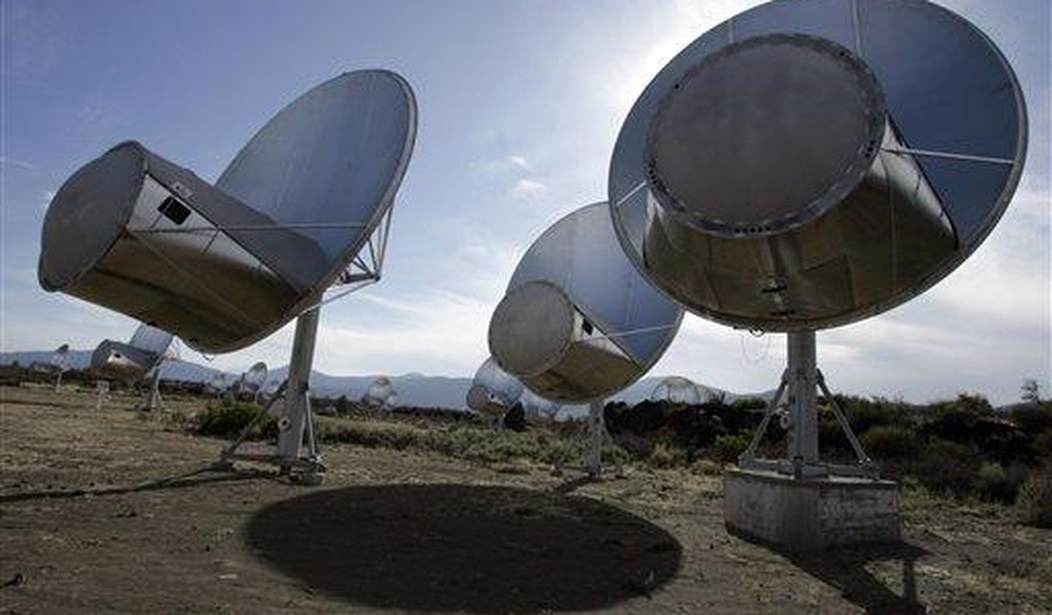My good friend Jazz Shaw at Hot Air wrote about NASA’s plan to send a detailed message into space, hoping to get a response. This “active” search for extraterrestrial intelligence, sometimes referred to as METI (Messaging Extraterrestrial Intelligence), has elicited one of the great scientific debates of our time. The debate centers on the question of whether aliens would be peaceful or not so peaceful.
The question is relevant considering that our efforts at exploring the universe for aliens thus far have been limited to “listening” to millions of channels on the radio spectrum, hoping to find evidence of a technological civilization in all the static and clutter.
This is “passive” SETI (Searching for Extraterrestrial Intelligence), and most scientists involved in SETI believe this is the best way to go about looking for life in the universe rather than broadcasting our existence to any and all who can hear.
In short, METI efforts have been limited in large part because of the very real fear that broadcasting humanity’s existence to the Universe could have serious consequences. Notable critics include Stephen Hawking and famed scientist and author David Brin. In a 2006 article titled, “Should we be Shouting at the Cosmos,” Brin expressed how many notable scientists objected to METI …
Sci-fi author Brin chaired a committee charged with recommending what humans should do in the event of first contact. More than almost any other scientist involved in SETI, he has pondered the question of active vs. passive SETI and has come down decisively in opposition to any active attempts to make first contact.
“Let there be no mistake. METI is a very different thing than passively sifting for signals from the outer space. Carl Sagan, one of the greatest SETI supporters and a deep believer in the notion of altruistic alien civilizations, called such a move deeply unwise and immature. (Even Frank Drake, who famously sent the “Arecibo Message” toward the Andromeda Galaxy in 1974, considered “Active SETI” to be, at best, a stunt and generally a waste of time.)
“Sagan — along with early SETI pioneer Philip Morrison — recommended that the newest children in a strange and uncertain cosmos should listen quietly for a long time, patiently learning about the universe and comparing notes, before shouting into an unknown jungle that we do not understand.”
The current NASA plan calls for NASA and Chinese astronomers to beam an extraordinarily complex message into space, giving any alien listening detailed instructions on how to reach us — and how to conquer us.
Astronomers Come up With a New Message to let the Aliens Know we're Here – Known as The Beacon in the Galaxy (BITG) message, this updated signal combines aspects of the original Arecibo Message with every METI attempt made to date. https://t.co/wEYbAPzM7g @universetoday pic.twitter.com/zUVXrQKtCG
— The SETI Institute (@SETIInstitute) April 1, 2022
“The proposed message includes basic mathematical and physical concepts to establish a universal means of communication followed by information on the biochemical composition of life on Earth, the Solar System’s time-stamped position in the Milky Way relative to known globular clusters, as well as digitized depictions of the Solar System, and Earth’s surface,” BITG creator Jonathan Jiang wrote in the study surrounding the message, “The message concludes with digitized images of the human form, along with an invitation for any receiving intelligences to respond.”
The debate is moot. As Jazz points out, we’ve been actively beaming SETI messages into space since radio was first utilized a hundred years ago. In truth, the civilization that could pick up those signals would be incredibly advanced compared to ours. And that’s the problem. Why is it the de facto position of many in the SETI community that an advanced culture is necessarily peaceful and benign?
What if they’re not particularly friendly? What if they would see the appearance of a new, technologically-capable species in their galactic neighborhood as a potential threat and decide to nip the problem in the bud? But NASA scientist and project co-founder Jonathan Jiang dismisses such concerns. “Logic suggests a species which has reached sufficient complexity to achieve communication through the cosmos would also very likely have attained high levels of cooperation amongst themselves and thus will know the importance of peace and collaboration,” he said.
Really? That seems like an awfully big assumption, doesn’t it? We’ve achieved the ability to communicate through the cosmos. Take a look around the planet, pal. Does it really look like humans have “attained high levels of cooperation” and “know the importance of peace and collaboration?” (For only one current example, see Putin, Vladimir.)
Related: Russian Space Agency Says It Will Suspend Cooperation on the Space Station
The Fermi Paradox — the notion that if the universe is teeming with life, why haven’t we made contact or discovered proof of their existence yet — applies to SETI, too. It could be that there are a lot of peaceful advanced societies out there with just a few exceptions. But those exceptions could destroy our planet, our civilization, and our species.
Better safe than sorry.










Join the conversation as a VIP Member